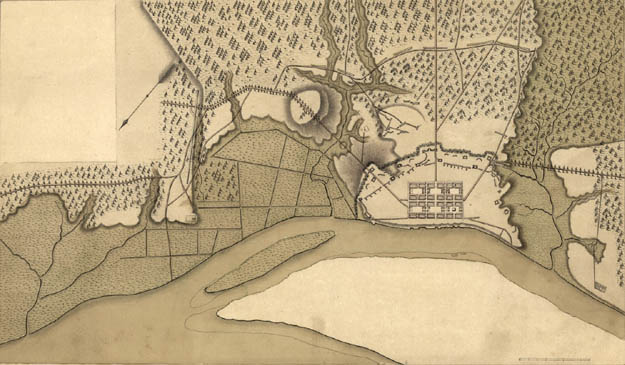Siege of Savannah
|
|
This Site:
|
1779 Siege of Savannah MapSavannah, the chief commercial city of Georgia; 18 miles from the Atlantic Ocean; county seat of Chatham county. Late in 1778 Sir Henry Clinton dispatched Lieutenant-Colonel Campbell with about 2,000 men to invade Georgia. He sailed from New York on November 27, under convoy of a portion of Commodore Hyde Parker's fleet. They arrived at the mouth of the Savannah on December 23, and, after much hindrance, made their way towards Savannah, opposed by General Robert Howe with about 600 Continentals and a few hundred militia. Howe was defeated, and fled, pursued by the invaders. Savannah passed into the hands of the British, with 453 prisoners, forty-eight cannon, twenty-three mortars, the fort (with its ammunition and stores), the shipping in the river, and a large quantity of provisions. The Americans lost, in killed or drowned, about 100 men; the British, about twenty-six killed and wounded. Howe, with the survivors, retreated into South Carolina. In August, 1779, Count d'Estaing appeared off the southern coast with twenty-two ships-of-the-line. General Lincoln, in command of the Southern army, was at Charleston, when a French frigate came there to announce the arrival of the fleet and the admiral's willingness to assist the army in the reduction of Savannah, provided he should not be detained too long on that dangerous coast, for he could find neither roadstead nor offing for his great ships-of-war. His entire fleet consisted of thirty-three vessels, bearing a large number of heavy guns. On the appearance of the fleet General Prevost summoned the troops from all his outposts to the defense of Savannah, and 300 negroes from the neighboring plantations were pressed into the service in strengthening the fortifications around the town. Very soon, under the direction of Major Moncrief, thirteen redoubts and fifteen batteries, with connecting lines of entrenchments were completed, on which seventy-six cannon were mounted. Before them a strong abatis was laid.
Meanwhile Lincoln had marched from Charleston, and reached the Savannah River on September 12; and on the same day French troops landed below Savannah and marched up to within 3 miles of the town. Lincoln approached, and on September 23 the combined armies commenced a siege. D'Estaing had demanded a surrender of the post on the 16th, when Prevost, hourly expected reinforcements of 800 Wien from Beaufort, asked for a truce, which was unwisely granted. The reinforcements came, and then Prevost gave a defiant refusal. The siege, begun on September 23, lasted until October 8, with varying success. During the last five days a heavy cannonade and bombardment had been kept up on the British works with very little effect. D'Estaing, impatient of delay, then proposed to take the place by storm. Lincoln reluctantly agreed to the proposal, for there seemed a certainty of final victory if the siege should continue. A plan of attack was revealed to Prevost by a citizen of Charleston—a sergeant in Lincoln's army—and gave the British a great advantage. The assault was made before dawn on October 9 by the combined forces, 4,500 strong, in three columns, led respectively by D'Estaing, Count Dillon, and Huger (of Charleston). They were shrouded in a dense fog and covered by the French batteries. After five hours of fierce conflict there was a truce for the purpose of burying the dead. Already 1,000 of the Americans and Frenchmen had been killed or wounded. Among the latter was D'Estaing, who was carried to his camp. Count Pulaski, at the head of his legion, was mortally wounded by a grape-shot. During the truce D'Estaing and Lincoln held a consultation. The former, having lost many men, wished to abandon the siege; the latter, confident of final success, wished to continue it. D'Estaing positively refused to remain any longer, and on the evening of October 18 the allies withdrew, the French to their ships, and the Americans Zubley's Ferry, on the Savannah. Lincoln retreated to Charleston, and the French fleet sailed for France at the beginning of November. The British lost only 120 men. Thus closed the campaign of 1779. On July 11, 1782, the British troops evacuated Savannah, after an occupation of three years and a half. In consideration of the services of General James Jackson, Wayne, who was in command of the Continentals in Georgia, appointed him to "receive the keys of Savannah from a committee of British officers." He did so, and on the same day the American army entered Savannah, when royal power ceased in Georgia forever. Governor Martin called a special meeting in Savannah (August 1), of the Georgia legislature, at the house of General McIntosh. Very soon the free and independent State of Georgia began its career. See GEORGIA. |
|
|
||
|
|
Site Copyright 2003-2018 Son of the South. For Questions or comments about this collection, contact: paul@sonofthesouth.net |
|
|
Are you Scared and Confused? Read My Snake Story, a story of hope and encouragement, to help you face your fears. |
||

